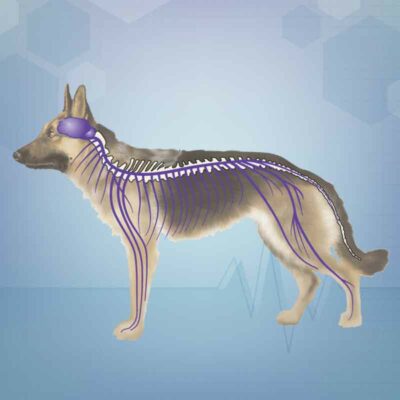 Nervous system disorders in dogs
Nervous system disorders in dogs
Similar to humans, neurological issues in dogs can result from various conditions and often surface with age. But what exactly constitutes a neurological disorder?
In canines, these disorders encompass a range of illnesses impacting your dog’s peripheral or central nervous system, leading to a variety of distressing and risky symptoms. Primarily affecting areas like the nerves, brain, and spinal cord, neurological disorders can be alarming for both dog and owner.
Understanding the signs to watch for and recognizing different types of neurological disorders in dogs allows you to promptly provide your dog with the necessary assistance when issues arise.
1. Epilepsy in Dogs
Epileptic seizures in dogs arise from abnormal brain electrical activity. Not all seizures are identical; they manifest in three distinct types, each exhibiting different symptoms.
Symptoms of Focal Seizures in Dogs
Focal Seizures occur within a specific brain region, leading to varied symptoms depending on the affected area:
- Episodic movements like head shaking or muscle contractions in a limb stem from abnormal brain activity in the motor region.
- Abnormal activity in the autonomic nervous system causes symptoms such as excessive salivation, dilated pupils, or vomiting.
- Seizures in other brain regions may result in unusual behaviors like restlessness, unexplained fear, or heightened anxiety.
Symptoms of Generalized Seizures in Dogs
Generalized Seizures occur on both sides of the brain, causing loss of consciousness. Movements affect both sides of the body and fall into five categories:
- Tonic seizures cause muscle stiffening.
- Clonic seizures result in rapid muscle contractions or jerking motions.
- Tonic-Clonic seizures transition from muscle stiffening to jerking contractions.
- Myoclonic seizures present as sporadic jerks.
- Atonic seizures, termed ‘drop attacks,’ lead to sudden loss of muscle tone and collapse.
Symptoms of Focal to Generalized Seizures in Dogs
Focal seizures often progress into generalized seizures. Pet parents might not notice the focal seizure, but recalling your dog’s behavior before a generalized seizure can aid diagnosis.
Dog Breeds with Elevated Susceptibility to Seizures
Seizures can impact dogs across different breeds, yet some are genetically more susceptible like:
- Golden Retrievers
- German Shepherds
- Bernese Mountain Dogs
- Labrador Retrievers
- Border Collies
- Australian Shepherds
- Collies
- Beagles
- Belgian Tervueren
Diagnosis of Epilepsy in Dogs
Epilepsy, a neurological condition, may have genetic origins. Tests aim to identify underlying causes for seizures. Structural epilepsy results from detected causes, while idiopathic epilepsy lacks apparent reasons.
Treatment for Epilepsy in Dogs
Though epilepsy has no cure, anti-epileptic drugs (AEDs) aim to minimize seizure severity and frequency without major side effects. Success rates range from 15-30%. Possible side effects include temporary symptoms like sleepiness, increased appetite, thirst, vomiting, diarrhea, and behavioral changes.
Dietary changes may impact epilepsy treatment effectiveness. Consultation with a vet before altering food habits is crucial.
Treatment success involves fewer and less severe seizures, aiming to reduce their frequency by half.
Leaving a dog with epilepsy alone requires creating a safe and comfortable environment to minimize risks if a seizure occurs while you’re away.


